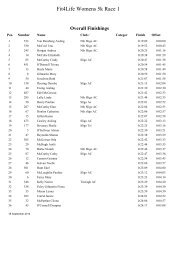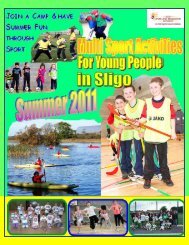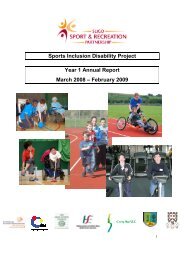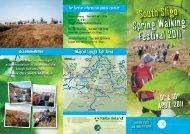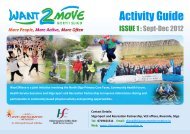Girls Active Programme - Sligo Sport and Recreation Partnership
Girls Active Programme - Sligo Sport and Recreation Partnership
Girls Active Programme - Sligo Sport and Recreation Partnership
You also want an ePaper? Increase the reach of your titles
YUMPU automatically turns print PDFs into web optimized ePapers that Google loves.
Discussion<br />
with girls. As a result, it is directly responsive to<br />
their needs <strong>and</strong> values their role as advisors as well<br />
as participants.<br />
Without initial financial support the schools were<br />
less likely to have undertaken the programme in<br />
the first instance, but now that the benefits are<br />
more visible all three case study schools were<br />
prepared to consider maintaining the programme<br />
independently at some level.<br />
As with the girls, the responses from staff in<br />
relation to the personnel involved in the programme<br />
were positive – school staff felt the steering group<br />
provided accessible <strong>and</strong> relevant support through<br />
the in-service day, instructors’ database, visits<br />
to schools <strong>and</strong> availability by phone. Principals<br />
appreciated the (voluntary) work of co-ordinators<br />
<strong>and</strong> co-ordinators felt that principals were<br />
supportive of the programme.<br />
5.2.3 Challenges<br />
The challenges for the programme were highlighted<br />
by girls <strong>and</strong> by school personnel as follows:<br />
a) Timing of sessions,<br />
b) Arrangements for instructors,<br />
c) Involvement of girls in organising activities,<br />
d) Limitations on numbers involved.<br />
Some <strong>Girls</strong> <strong>Active</strong> sessions occur at lunchtime<br />
<strong>and</strong> some after school <strong>and</strong> it appears that both<br />
schedules have associated problems. Lunch is<br />
no more than an hour long <strong>and</strong> commonly utilised<br />
for extra-curricular activities. For <strong>Girls</strong> <strong>Active</strong>, it<br />
can be difficult to acquire instructors at lunchtime<br />
<strong>and</strong> sessions may be necessarily curtailed. On the<br />
other h<strong>and</strong>, some girls find it more difficult to attend<br />
evening sessions especially if they live a distance<br />
from the school <strong>and</strong> rely on buses to get home.<br />
While the <strong>Girls</strong> <strong>Active</strong> programme is intended to<br />
be additional to the formal curriculum, within the<br />
context of a ‘whole school’ environment all extracurricular<br />
activity is viewed as an important part<br />
of a student’s development <strong>and</strong> indeed as ‘cocurricular’<br />
to the main programme of teaching<br />
undertaken by schools. In the ‘whole school’,<br />
therefore, lunchbreak becomes an equally<br />
important part of the student’s day <strong>and</strong> adequate<br />
provision will be seen as important for all such<br />
activities. <strong>Programme</strong>s such as <strong>Girls</strong> <strong>Active</strong> are,<br />
therefore, more likely to prosper in the ‘whole<br />
school’ context.<br />
Instructors’ fees arose as an issue for school staff<br />
<strong>and</strong> for support agencies. In some cases it appears<br />
that the fee has to be supplemented by a charge<br />
on the participating girls or on the school itself,<br />
especially in cases where costly activities such as<br />
horse-riding are undertaken. Charges did not arise<br />
as an issue for girls either in the questionnaire or<br />
focus groups. Sourcing of tutors is also an ongoing<br />
difficulty for some schools. The establishment of<br />
the database <strong>and</strong> the sharing of contacts between<br />
co-ordinators has alleviated the problem to some<br />
extent. It is, however, important, that the database<br />
is comprehensive <strong>and</strong> updated regularly.<br />
A distinctive characteristic of <strong>Girls</strong> <strong>Active</strong> is that<br />
the girls are actively involved in choosing <strong>and</strong><br />
organising the activities. In practice, however, the<br />
former appears to work better than the latter as<br />
over 80% felt they had an input into selecting the<br />
type of activities undertaken whereas only just over<br />
a third claimed that they have a say in organising<br />
the programme. In Phase One, two girls from<br />
each participating school underwent leadership<br />
training to enable them to contribute to organising<br />
the programme in their school. However, in itself<br />
this created a sense of inequality within the group<br />
<strong>and</strong> in the following years a h<strong>and</strong>book for girls was<br />
developed <strong>and</strong> distributed to participating groups<br />
instead. Teachers commented that with time<br />
pressures <strong>and</strong> other logistics it can be hard to get<br />
the girls involved. This aspect of the programme<br />
merits further investigation.<br />
Despite the fact that the principle of voluntary<br />
participation is built into <strong>Girls</strong> <strong>Active</strong>, one of the<br />
case study schools reported that it was made<br />
m<strong>and</strong>atory for the participating group to attend<br />
<strong>Girls</strong> <strong>Active</strong> activities. This was counterbalanced<br />
to some extent by the ‘treats’ provided for the<br />
girls during the year that helped to create a group<br />
Evaluation of the <strong>Girls</strong> <strong>Active</strong> <strong>Programme</strong> - 2003 – 2005 Report 27



